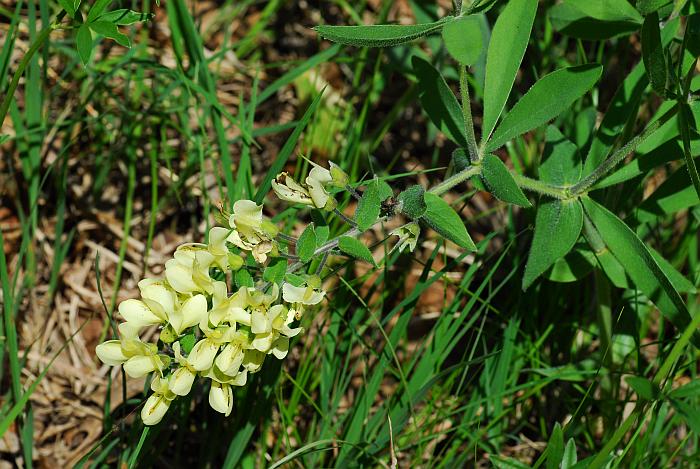Baptisia bracteata Muhl. ex Elliott
Cream White Indigo

Native
CC = 7
CW = 5
MOC = 65
© SRTurner
Baptisia bracteata Muhl. ex ElliottCream White Indigo | |
 |
Native CC = 7 CW = 5 MOC = 65 |
© SRTurner |
|
Family - Fabaceae/Faboideae Habit - Perennial forb from a thick caudex. Plants blackening upon drying, the herbage sparsely to densely pubescent with persistent, fine hairs. Stems - Spreading to loosely ascending, to 50 cm, finely pubescent, finely to moderately ribbed, with mostly spreading branches, not glaucous.
Leaves - Trifoliate, stipulate, short-petiolate, the uppermost rarely reduced to 1 or 2 leaflets. Petiole 1-9 mm long (but sometimes somewhat indistinct, because of winglike extensions of the lateral leaflets). Stipules leaflike, 10-40 mm long, lanceolate to narrowly ovate, persistent. Leaflets 3-9 cm long, finely hairy, oblanceolate to narrowly obovate or occasionally elliptic, rounded to bluntly or sharply pointed at the tips.
Inflorescence - Racemes 10-30 cm long, spreading laterally, positioned below the foliage, with relatively few to many flowers, the stalk 3-6 cm long. Bracts 10-30 mm long, leaflike and conspicuous, lanceolate to narrowly heart-shaped, persistent.
Calyces - Calyces with the tube bell-shaped, 4-6 mm long, the lobes triangular, 3-5 mm long, the margins and outer surface finely hairy.
Flowers - Corollas papilionaceous, cream to light yellow, the banner 16-22 mm long, 14-20 mm wide, the wings 22-26 mm long, 7-8 mm wide, the keel 20-26 mm long, 7-9 mm wide. Stamens with the filaments 18-20 mm long, the anthers 1.4-2.0 mm long. Ovary 8-12 mm long, hairy, the style 10-14 mm long.
Fruits - Inflated legumes, 3.5-5.0 cm long (excluding the stalklike base and beak), 14-25 mm wide, narrowly ellipsoid, tapered to a stalklike base 7-10 mm long, tapered gradually to the beak, this 15-20 mm long, hairlike toward the tip, the walls relatively thick and leathery to hardened, hairy when young, but sometimes nearly glabrous at maturity. Seeds 3-4 mm long, 2-3 mm wide, greenish brown to brown with warty, resinous dots. Flowering - April - June. Habitat - Upland prairies, glades, forest openings, pastures, railroads, roadsides. Origin - Native to the U.S. Lookalikes - When flowering, this plant is not easily mistaken. Vegetatively it can be confused with other members of the genus. Other info. - This plant is common throughout most of Missouri. Its U.S. range occupies a well-defined band ranging from Wisconsin down through eastern Texas. Unlike other Missouri members of the genus, this plant's inflorescences are lateral, projecting from the side of the plant rather than upright and terminal. Other unique attributes include the conspicuous leafy bract which subtends each flower and the general hairiness of the foliage. These characters permit identification even when open flowers are not present. The species has been subdivided, with Missouri material corresponding to var. leucophaea. Photographs taken at Don Robinson State Park, Jefferson County, MO, 4-23-2017 and 5-9-2018 (SRTurner). |